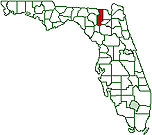County Hotel Owners Complain About Homeless Under the Interstate at U.S. 90 – FDOT to Step In
Posted February 13, 2019 06:15 am | (2 comments)
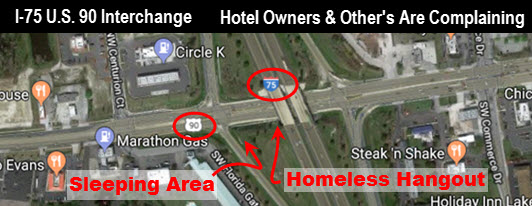
 COLUMBIA COUNTY, FL – As the January 23,
2019 Tourist Development Council (TDC)
meeting got underway, TDC Director Paula
Vann announced, "At the last TDC meeting I
brought up that the hotel owners were asking
that we do some improvements or ask DOT to
do some improvements at the I-75 and Highway
90 exit." As a result, Ms. Vann invited
Florida Department of Transportation's
(FDOT) landscape team to the TDC. Twenty
minutes after the meeting began, DOTs Marty
Humphreys said, "We have a little issue out
there... We've been working with law
enforcement."
COLUMBIA COUNTY, FL – As the January 23,
2019 Tourist Development Council (TDC)
meeting got underway, TDC Director Paula
Vann announced, "At the last TDC meeting I
brought up that the hotel owners were asking
that we do some improvements or ask DOT to
do some improvements at the I-75 and Highway
90 exit." As a result, Ms. Vann invited
Florida Department of Transportation's
(FDOT) landscape team to the TDC. Twenty
minutes after the meeting began, DOTs Marty
Humphreys said, "We have a little issue out
there... We've been working with law
enforcement."
Anyone that drives under I-75 on U.S. 90 will, at one time or another, notice a group of men, or men and women, hanging out under the overpass.
The south bound exit ramp from I-75 to U.S. 90 usually also has a panhandler or two at the stop sign.
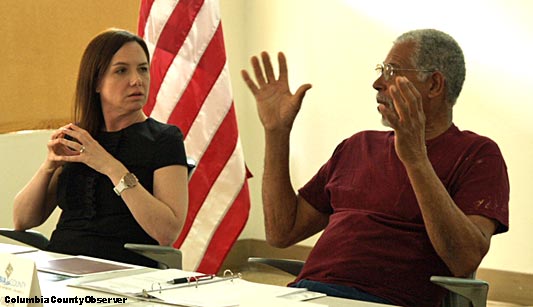
County 5 and TDC Chair, Commissioner Ronald
Williams gestures to demonstrate his
perception of the enormity of the problem as
TDC Director Paula Vann looks on.
This appears to be the complaint of the hotel owners and many others.
Looking For a Solution
TDC Calls in FDOT's Landscape Crew
District 2's landscape architect, Ken Cheek, introduced himself and gave an overview of the district, which is quite expansive. The district includes 18 counties and 7 major cities and has a population of 1.9 million residents.
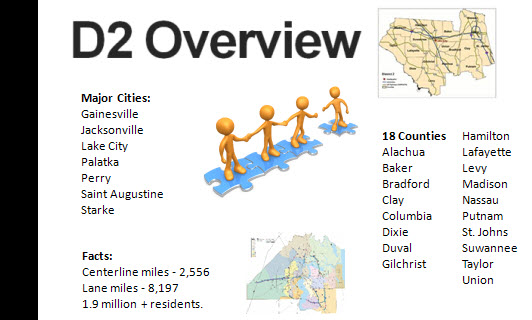
Columbia County has a population of approximately 69,000 and political influence.
Mr. Cheek introduced the FDOTree program which he said establishes relationships with civic leaders and "communities that are environmentally impacted."
The FDOTree program also "develops internal design partnerships within the District to take advantage of landscape opportunities prior to construction."
There was nothing in the FDOT PowerPoint presentation which included solving the County's homeless and panhandler issues.
There is also no County agency or County employee that has been tasked with dealing with those issues.
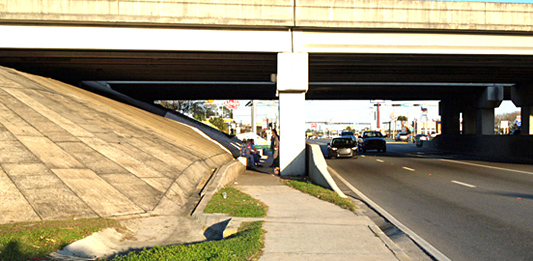
The County, hotel owners, and others claim
this as a problem for the image of Columbia
County, folk under the underpass.
Landscape Funding
Mr. Cheek told the group, "Funding requests take from 2 to 5 years."
Discussing the I-75 U.S. 90 interchange he continued, "If we come to an agreement today that we're going to landscape it, it may take from 2 to 5 years. That's just the way it works. "Trust me; it's a long process... A standard project takes a long time to get done."
"A Little Issue Out There, It's Called Panhandlers"
FDOT's Marty Humphreys, the District's Operations Engineer was next to address the group. Mr. Humphries oversees all construction, which would include landscaping, around the Lake City area.
Mr. Humphreys said, "I know there's a challenge at I-75 and U.S. 90. We have a little issue out there. I'm sure you've all seen it. It's called panhandlers. They crawl up in it [the grass] and sleep. We're tryin' to figure out a way to limit the panhandler. We've been working with law enforcement."
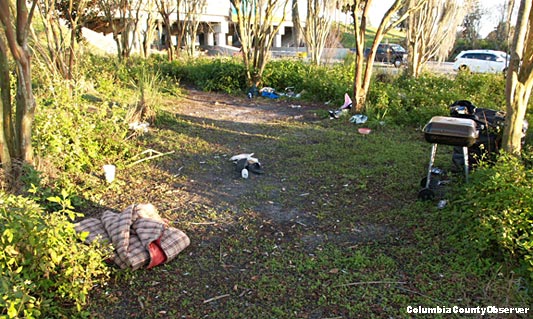
A barbeque and sleeping items in the high
grass and brush. DOT agreed to remove the
brush.
TDC Director Vann asked, "What is the process to get the ball rolling if we decided today we would like to look into this more?"
Mr. Cheek answered, "Send me an email."
Ms. Vann asked if there would be a cost for the County.
Mr. Cheek answered, "No. It can be done, but it will take time."
Commissioner Ronald Williams asked, "I hear you say it would take a year to design?"
Mr. Cheek: "Yes," adding, "We can do a conceptual plan if that is what you would like us to do."
After a brief discussion the TDC said they wanted the landscaping changed so that people could not be hidden by the tall grass and shrubs at the interchange.
Mr. Humphries attempted a joke, "Did I hear you right when you said you didn't want any of that grass under there?"
The group had a collective chuckle.
Mr. Humphries followed up, "So if I was to take it out you'd be OK with that?"
Commissioner Murphy added, "I think that all need to be rock."
Everyone agreed that it was important to see what was going on.
Mr. Cheek said, "Very good, we'll set something up."
The Homeless & Panhandlers

It is not clear how many thousands of
dollars DOT will spend remodeling the
already landscaped areas of the interchange, or
if that money could be put to better use.
Presently, there are no real time figures in the County regarding the homeless.
Recently, United Way of Suwannee Valley sent volunteers to the known homeless spots, including the I-75 U.S. 90 interchange.
According to Executive Director Jennifer Anchors, a report regarding the County's homeless should be available in about two weeks.
On February 4, 2019, your reporter spoke with some of the folk hanging out under the interchange. None would give their names. There were only a handful of people. They weren't bothering anybody.
Your reporter advised the group that the County was working with DOT to cut down and remove all the brush and tall grass so that no one could sleep there.
One person said, "What do they want to do that for?"
Another said, "What's it to them. We're not bothering anybody. Why shouldn't we be able to sleep there?"
